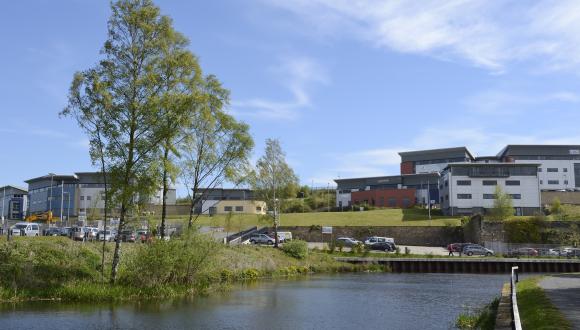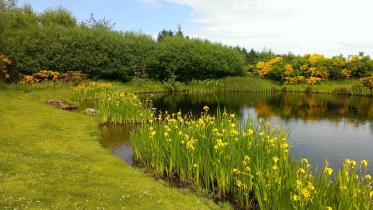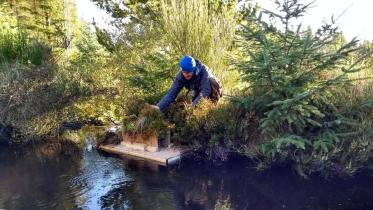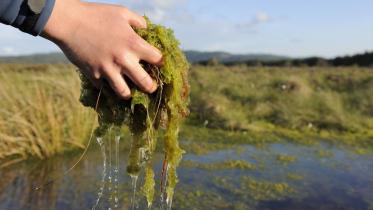Standing advice for planning consultations - Water Voles
This is standing advice to help planning applicants seeking permission for development that could affect water voles, and to assist planning officers and other regulators in their assessment of these applications
This is standing advice to help planning applicants seeking permission for development that could affect water voles, and to assist planning officers and other regulators in their assessment of these applications. It avoids the need for us to advise on individual planning consultations in relation to water voles. We will only provide further advice in exceptional circumstances that are not covered by this standing advice.
Consideration of protected species in development management
Scottish Planning Policy requires that the presence (or potential presence) of legally protected species is factored into the planning and design of development proposals, and that any impacts on protected species are fully considered prior to the determination of planning applications.
Where impacts on a protected species cannot be avoided, certain activities may only be undertaken with a licence from NatureScot. It is important that any licensing issues are considered as part of a planning application to avoid any unnecessary delay to a development proceeding.
Legal protection for water voles
Water voles are protected by the Wildlife and Countryside Act 1981 (as amended). This protection is currently restricted to a water vole’s place of shelter. It is an offence to intentionally or recklessly:
- damage, destroy or obstruct access to a water vole burrow;
- disturb a water vole while it is using its burrow.
This means that if water voles could be affected in these ways by a development, and no action is taken to prevent it, an offence may be committed. The advice below will help ensure that impacts on water voles are minimised and no offences occur.
When a development could affect water voles
Water voles have a widespread but patchy distribution in Scotland, though absent from most islands. For an up to date map of water vole distribution see the National Biodiversity Network Atlas. To more accurately reflect the current distribution use the interactive data selection facility to select records from 2000 onwards. Any records prior to 2000 are likely to be unreliable, due to the massive decline in the water vole population, particularly during the latter part of the 20th century. The NBN Atlas map indicates the broad pattern of distribution across Scotland but cannot provide detailed
information for individual development sites. Local Record Centres may have additional information that can help determine if water voles are likely to be present. See also the Atlas of the Mammals of Great Britain & Northern Ireland (The Mammal Society/Pelagic Publishing 2020).
Lowland habitat that may support water voles includes small slow-flowing or static burns, backwaters, canals, ditches and overgrown field drains. This can sometimes be in intensive farmland and urban areas. Suitable watercourses are usually less than 3m wide and 1m deep, without any extreme fluctuations in water level, and have well vegetated banks with steep or stepped profiles where water voles can make burrows above the water table. In upland locations, water voles can be found in narrow moorland burns on flat or gently sloping ground with thick deposits of peat. Typical sites are near the headwaters of a river system, or in the upper reaches of glaciated valleys where small burns meander across a marshy floodplain with rushes and sedges. A water vole survey should be carried if development works are within 10m of suitable habitat within the water vole’s range.
In and around north-east Glasgow care needs to be taken not to overlook water vole colonies that occur in grasslands without any aquatic habitat, especially as many of these sites have been zoned for new housing or other development. Further information and advice is provided on the Glasgow City Council website, including Interim guidelines for the conservation management of urban grassland water voles (The Glasgow Water Vole Project 2019).
Carrying out a water vole survey
Water vole surveys should be done by persons with appropriate knowledge of water vole ecology and practical experience of water vole survey work. They include a search for signs of water voles up to 2m from the water’s edge along all watercourses or pond banks that might be affected by a proposal. Water vole signs include burrows, runs, tracks, feeding stations, droppings and latrines. The distance upstream and downstream from the development site that should be surveyed requires some judgement, and will depend on the size and nature of the development. For small developments, this can be 50m upstream and downstream of the site. For larger schemes affecting several 100m of riparian habitat, and where the development may lead to significant fluctuations in water levels, it would be appropriate to extend surveys to 500m upstream and downstream of the site.
In some habitats, e.g. upland blanket bog and rush-dominated marshy grassland, water voles may occur well away from the riparian zone, in which case it will be necessary to extend the survey further away from the waterside into the adjoining habitat. How far will depend on local circumstances.
Surveys can be carried out between April and October, when the animals are most active above ground; or from May to September in upland locations. The ideal period to undertake a survey is June to August. Avoid periods following high water when droppings and other signs may have been washed away.
Further details of water vole survey methods are provided in The Water Vole Mitigation Handbook (The Mammal Society 2016); and specifically with respect to hydro schemes (but relevant to other upland development) in Annex C of Guidance for applicants on supporting information requirements for hydropower applications (SEPA 2014).
The survey information needs to be sufficiently up-to-date when a planning application is submitted. Pre-application water vole surveys normally remain valid for two more survey periods, and should be repeated if the application is going to be delayed beyond the start of a third survey period. Unless it is clearly evident that there has been no substantive change in number, distribution or activity of water voles since the original survey was undertaken.
Reporting survey results
If a development proposal has needed a water vole survey, a survey report must be submitted as part of the planning application. The report should include:
- names and experience of surveyors;
- details of any information gathered from Local Record Centres or other sources;
- descriptions of habitat surveyed and any limitations to the survey, such as access;
- survey methods, including survey area, date, time and weather conditions;
- a map showing the location of water vole signs and burrows in relation to the development;
- an assessment of how the development might affect water voles.
If water voles could be affected by the proposal, the report must include a protection plan. The plan should include:
- measures proposed to minimise impacts on water voles, including annotated maps and/or photographs showing the location of any measures proposed and how they relate to survey information and construction work;
- a summary of any residual impacts once the above measures are taken into account;
- details of any licensing requirements.
Measures to minimise impacts on water voles
Measures to minimise impacts on water voles should follow a hierarchy of avoidance, mitigation and compensation:
Avoidance
- Design the development and construction methods to avoid water vole habitat and maintain habitat corridors and access to high ground in flood-prone areas.
Mitigation
- Mark 10m work exclusion zones around water vole habitat. Where a 10m exclusion zone is not possible around active water vole burrows a licence will be required from NatureScot before works can proceed.
- Install over-sized or box shaped culverts where necessary to assist passage of water voles.
- Trap and translocate1 water voles to another suitable area, ideally as close to the affected area as possible. This should be done prior to the breeding season in early spring. Translocation in the autumn is not recommended but may, in exceptional circumstances, be necessary2. This can be a significant operation and should only be considered where there are no other practical solutions. This will require a licence from NatureScot.
-
Although live-trapping water voles above ground and away from their burrow entrances does not currently require a licence in Scotland, we consider their capture and subsequent translocation (other than to approved receptor sites nearby) to be bad practice - especially where they are to be used for captive breeding. This is unlikely to be supported unless part of a carefully planned, agreed strategic approach to water vole conservation that follows the process detailed in the Scottish Code for Conservation Translocations. Any such proposals may also require a consent on a designated site.
1 The “displacement” method, involving the removal of surface vegetation to encourage water voles to move away from affected areas, is no longer generally recommended, although it may still be considered at some small sites (<50m of watercourse). If this method is proposed, a careful destructive search of the affected burrows, using hand tools, will be required, to check that any animals present have been displaced. It will require a licence from NatureScot before works can proceed.
2 In which case, late September/early October is likely to be the least disruptive time.
Compensation
- Create water vole habitat to replace any habitat loss or enhance existing habitat, including linkages between habitat. Where appropriate, new habitat can be created as part of a Sustainable Urban Drainage System.
Further details regarding mitigation measures are provided in The Water Vole Mitigation Handbook (The Mammal Society 2016).
For all development proposals where water voles are a consideration, pre-construction surveys should be timetabled into project plans. This is to enable checks for any new burrows that may have become occupied after the original survey, and to ensure the measures proposed to minimise impacts on water voles remain appropriate. Pre-construction surveys should be completed as close to the start of works as possible, and always within the most recent survey period.
Licensing development works affecting water voles
Licences for development works that would otherwise result in an offence with respect to water voles can only be issued if:
a) the development will give rise to significant social, economic or environmental benefit (see Protected Species Licensing: Licences for ‘social, economic or environmental purposes’) and
b) there is no other satisfactory solution.
There is a presumption against licensing disturbance or damage/destruction of burrows while they contain dependent young. Any licensed activity in these circumstances would have to wait until the water voles had finished breeding.
For advice on whether or not a licence is likely to be granted, planning applicants and planning officers may contact the NatureScot licensing team. An up-to-date water vole survey and a water vole protection plan for the proposed development must be submitted with the enquiry, together with details of the development proposals. We would normally only expect these enquires when proposals may reduce available water vole habitat to such an extent that the local population viability may be affected and/or trapping and translocation may be required.
Guidance on applying for a water vole licence for development purposes, along with the application form can be found on our website. For further information on protected species licensing see Protected Species Licensing: Legislation, Appropriate Authorities and Licensing Purposes.
Contact
If you already have a licence number, include it in the subject line of your email, or have it to hand when you call.






